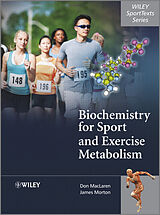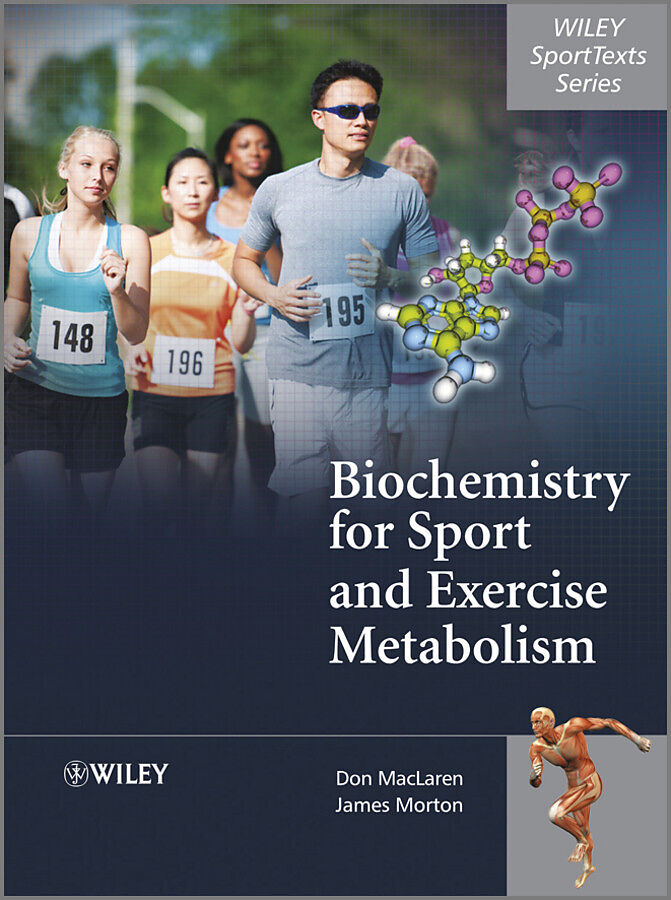Biochemistry for Sport and Exercise Metabolism
Format:
E-Book (EPUB)
EAN:
9781119967828
Untertitel:
Englisch
Genre:
Biochemie, Biophysik
Autor:
Donald MacLaren, James Morton
Herausgeber:
Wiley
Auflage:
2. Aufl.
Anzahl Seiten:
264
Erscheinungsdatum:
05.12.2011
ISBN:
978-1-119-96782-8
How do our muscles produce energy for exercise and what are the
underlying biochemical principles involved? These are questions
that students need to be able to answer when studying for a number
of sport related degrees. This can prove to be a difficult task for
those with a relatively limited scientific background.
Biochemistry for Sport and Exercise Metabolism addresses
this problem by placing the primary emphasis on sport, and
describing the relevant biochemistry within this context.
The book opens with some basic information on the subject,
including an overview of energy metabolism, some key aspects of
skeletal muscle structure and function, and some simple biochemical
concepts. It continues by looking at the three macromolecules which
provide energy and structure to skeletal muscle - carbohydrates,
lipids, and protein. The last section moves beyond biochemistry to
examine key aspects of metabolism - the regulation of energy
production and storage. Beginning with a chapter on basic
principles of regulation of metabolism it continues by exploring
how metabolism is influenced during high-intensity, prolonged, and
intermittent exercise by intensity, duration, and nutrition.
Key Features:
* A clearly written, well presented introduction to the
biochemistry of muscle metabolism.
* Focuses on sport to describe the relevant biochemistry within
this context.
* In full colour throughout, it includes numerous illustrations,
together with learning objectives and key points to reinforce
learning.
Biochemistry for Sport and Exercise Metabolism will prove
invaluable to students across a range of sport-related courses, who
need to get to grips with how exercise mode, intensity, duration,
training status and nutritional status can all affect the
regulation of energy producing pathways and, more important, apply
this understanding to develop training and nutrition programmes to
maximise athletic performance.
Autorentext
Don MacLaren is currently Professor of Sports Nutrition at Liverpool. He has taught physiology, biochemistry and nutrition at JMU for a number of years. He is Chair of the BASES Sports Nutrition interest group and is a member of the Sport & Exercise Nutrition working party under the auspices of the Nutrition Society. James Morton is a lecturer in sports metabolism. He has twice received 'Young Investigator Awards' from the European College of Sports Science, in 2006 and 2008.
Zusammenfassung
How do our muscles produce energy for exercise and what are the underlying biochemical principles involved? These are questions that students need to be able to answer when studying for a number of sport related degrees. This can prove to be a difficult task for those with a relatively limited scientific background. Biochemistry for Sport and Exercise Metabolism addresses this problem by placing the primary emphasis on sport, and describing the relevant biochemistry within this context. The book opens with some basic information on the subject, including an overview of energy metabolism, some key aspects of skeletal muscle structure and function, and some simple biochemical concepts. It continues by looking at the three macromolecules which provide energy and structure to skeletal muscle - carbohydrates, lipids, and protein. The last section moves beyond biochemistry to examine key aspects of metabolism - the regulation of energy production and storage. Beginning with a chapter on basic principles of regulation of metabolism it continues by exploring how metabolism is influenced during high-intensity, prolonged, and intermittent exercise by intensity, duration, and nutrition. Key Features: A clearly written, well presented introduction to the biochemistry of muscle metabolism. Focuses on sport to describe the relevant biochemistry within this context. In full colour throughout, it includes numerous illustrations, together with learning objectives and key points to reinforce learning. Biochemistry for Sport and Exercise Metabolism will prove invaluable to students across a range of sport-related courses, who need to get to grips with how exercise mode, intensity, duration, training status and nutritional status can all affect the regulation of energy producing pathways and, more important, apply this understanding to develop training and nutrition programmes to maximise athletic performance.
Inhalt
Preface xi One: Basic Muscle Physiology and Energetics 1 1 Energy sources for muscular activity 3 1.1 Adenosine triphosphate: the energy currency 3 1.2 Energy continuum 4 1.3 Energy supply for muscle contraction 4 1.4 Energy systems and running speed 7 1.5 Why can't a marathon be sprinted? 7 1.6 Energy sources and muscle 8 1.7 Can muscle use protein for energy? 9 1.8 Key points 10 2 Skeletal muscle structure and function 11 2.1 Skeletal muscle structure 12 2.1.1 Gross anatomical structure 12 2.1.2 The muscle fibre 13 2.2 Muscle contraction 18 2.2.1 Propagation of the action potential 18 2.2.2 Excitation-contraction coupling 18 2.2.3 The sliding filament mechanism 20 2.3 Muscle fibre types 21 2.3.1 General classification of muscle fibres 21 2.3.2 Muscle fibre distribution 23 2.3.3 Muscle fibre recruitment 24 2.4 Muscles in action 26 2.4.1 Types of muscle contraction 26 2.4.2 The twitch contraction 26 2.4.3 The length-tension relationship 27 2.4.4 Tetanus contractions 27 2.4.5 Force-velocity relationship 28 2.4.6 Muscle fatigue 29 2.5 Key points 29 3 Biochemical concepts 31 3.1 Organization of matter 32 3.1.1 Matter and elements 32 3.1.2 Atoms and atomic structure 32 3.1.3 Atomic number and mass number 34 3.1.4 Atomic mass 34 3.1.5 Ions, molecules, compounds and macronutrients 34 3.2 Chemical bonding 35 3.2.1 Ionic bonds 36 3.2.2 Covalent bonds 36 3.2.3 Molecular formulae and structures 38 3.2.4 Functional groups 39 3.3 Chemical reactions, ATP and energy 40 3.3.1 Energy 40 3.3.2 ATP 41 3.3.3 Units of energy 42 3.3.4 Types of chemical reactions 43 3.4 Water 45 3.4.1 General functions of water 45 3.4.2 Water as a solvent 46 3.5 Solutions and concentrations 46 3.6 Acid-base balance 47 3.6.1 Acids, bases and salts 47 3.6.2 pH Scale 48 3.6.3 Buffers 49 3.7 Cell structure 49 3.7.1 The plasma membrane 50 3.7.2 The nucleus 51 3.7.3 Cytoplasm and organelles 51 3.8 Key points 53 Two: Fundamentals of Sport and Exercise Biochemistry 55 4 Proteins 57 4.1 Protein function 58 4.1.1 General protein function 59 4.2 Amino acids 62 4.2.1 Amino acid structure 62 4.3 Protein structure 62 4.3.1 Primary structure 62 4.3.2 Secondary structure 65 4.3.3 Tertiary structure 65 4.3.4 Quaternary structure 65 4.4 Proteins as enzymes 67 4.4.1 Mechanisms of enzyme action 67 4.4.2 Factors affecting rates of enzymatic reactions 68 4.4.3 Coenzymes and cofactors 70 4.4.4 Classification of enzymes 70 4.4.5 Regulation of enzyme activity 72 4.5 Protein turnover 73 4.5.1 Overview of protein turnover 73 4.5.2 DNA structure 73 4.5.3 Transcription 74 4.5.4 The genetic code 74 4.5.5 Translation 76 4.6 Amino acid metabolism 78 4.6.1 Free amino acid pool 79 4.6.2 Transamination 79 4.6…

Leider konnten wir für diesen Artikel keine Preise ermitteln ...
billigbuch.ch sucht jetzt für Sie die besten Angebote ...
Die aktuellen Verkaufspreise von 3 Onlineshops werden in Realtime abgefragt.
Sie können das gewünschte Produkt anschliessend direkt beim Anbieter Ihrer Wahl bestellen.
Loading...
Die aktuellen Verkaufspreise von 3 Onlineshops werden in Realtime abgefragt.
Sie können das gewünschte Produkt anschliessend direkt beim Anbieter Ihrer Wahl bestellen.
| # | Onlineshop | Preis CHF | Versand CHF | Total CHF | ||
|---|---|---|---|---|---|---|
| 1 | Seller | 0.00 | 0.00 | 0.00 |
